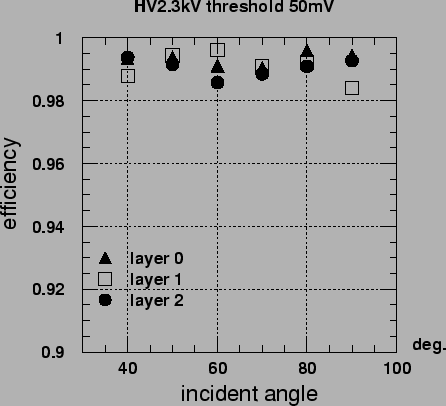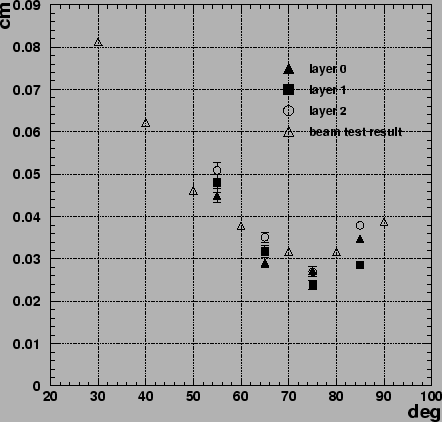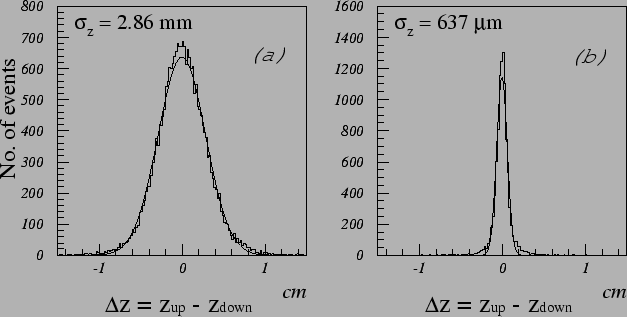



Next: Performance
Up: Calibration with Cosmic Rays
Previous: CDC
Contents
The performance test was carried out using cosmic rays before the CDC
was installed into the Belle detector. Data were taken with a simple
trigger system with scintillation counters located in the inner
cylinder to select cosmic rays that passed through the beam pipe area
inside CDC. Without any special optimization, the anode wire data
provide an extrapolation resolution of 160  m in the
m in the  -
- plane and 3.6 mm in the
plane and 3.6 mm in the  direction to the CDC cathode part.
Anode-wire tracks were used to estimate the detection efficiency of
the cathode readout.
direction to the CDC cathode part.
Anode-wire tracks were used to estimate the detection efficiency of
the cathode readout.
The charge distribution on the cathode strips depends on the
anode-cathode gap and the spread of the avalanche at the anode. When
an incoming particle is inclined with respect to the normal incidence,
the electron avalanche is spread along the anode wire, making the
induced charge distribution broader. This effect was made minimal
owing to the gate expansion and the limitation of the charge
integration time to 150 ns.
Consecutive cathode hits are recognized as a "cluster". At least
three strips are required to form a cluster. If two local charge
maxima are separated more than three strips, they are regarded as
separate clusters. The matching of a track to a cathode-hit cluster
is done by requiring that the extrapolated  is within the
is within the
 and
and  region covered by the cathode strip hits
and that the extrapolated
region covered by the cathode strip hits
and that the extrapolated  is within the
is within the  region covered by the
strip hits.
Fig.
region covered by the
strip hits.
Fig. ![[*]](./icons/crossref.png) shows the cathode efficiency as a
function of incident angle for
shows the cathode efficiency as a
function of incident angle for  = 50 mV and an anode high
voltage at 2.3 kV. The cathode strip efficiency is defined as the
ratio of the number of matched tracks to the number of sampled tracks.
As the Belle tracking trigger requires at least two hits in the three
cathode layers for each track, the trigger efficiency by the cathode
strips is better than 99%, even for the worst case of the incident
angle of
= 50 mV and an anode high
voltage at 2.3 kV. The cathode strip efficiency is defined as the
ratio of the number of matched tracks to the number of sampled tracks.
As the Belle tracking trigger requires at least two hits in the three
cathode layers for each track, the trigger efficiency by the cathode
strips is better than 99%, even for the worst case of the incident
angle of  where the cathode charge is smallest due to gas gain
saturation.
where the cathode charge is smallest due to gas gain
saturation.
The spatial resolution of the cathode readout was obtained with the
self-tracking method in the  direction using cathode data alone.
Fig.
direction using cathode data alone.
Fig. ![[*]](./icons/crossref.png) shows measured results of the
intrinsic cathode resolution as a function of incident angle. The
data for the three layers are consistent. The data measured in a beam
test using a prototype detector is also shown [4].
shows measured results of the
intrinsic cathode resolution as a function of incident angle. The
data for the three layers are consistent. The data measured in a beam
test using a prototype detector is also shown [4].
Figure:
Angular dependence of the cathode detection efficiency.
 |
Figure:
Angular dependence of the cathode resolution.
 |
To evaluate the improvement in the three dimensional tracking provided
by the cathode data, each cosmic ray track that passed through the
entire CDC was treated as two separate tracks (up and
down) going outwards from the beam pipe area. The tracking
performance was evaluated by checking the mismatch of these two track
segments,
 , at the closest approach to
the beam axis.
Figs.
, at the closest approach to
the beam axis.
Figs. ![[*]](./icons/crossref.png) (a) and (b) show
(a) and (b) show  distributions
respectively (a) without and (b) with including the cathode cluster
information in three dimensional tracking with the axial and stereo
anode wire information. The
distributions
respectively (a) without and (b) with including the cathode cluster
information in three dimensional tracking with the axial and stereo
anode wire information. The  resolution was improved from
about 3 mm to 0.64 mm with the cathode data. We note that
resolution was improved from
about 3 mm to 0.64 mm with the cathode data. We note that  z
obtained in the present analysis is equivalent to
z
obtained in the present analysis is equivalent to  times of
the track extrapolation resolution of CDC to the interaction point.
times of
the track extrapolation resolution of CDC to the interaction point.
Figure:
The effect of the cathode readout information on
 for cosmic ray tracks: (a) without and (b) with the
use of the cathode information in tracking, respectively.
for cosmic ray tracks: (a) without and (b) with the
use of the cathode information in tracking, respectively.
 |




Next: Performance
Up: Calibration with Cosmic Rays
Previous: CDC
Contents
Samo Stanic
2001-06-02

